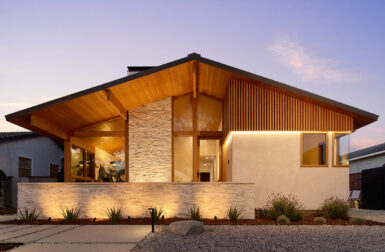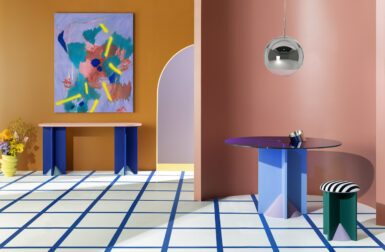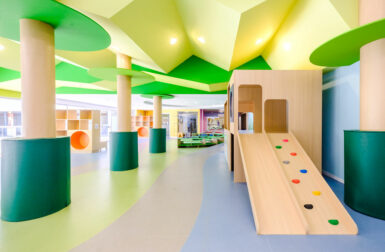This month’s Deconstruction comes from Nervous System, a product design company founded in 2007 by Jessica Rosenkrantz and Jesse Louis-Rosenberg. Using their backgrounds in architecture, design, math and biology, they create one-of-a-kind organic-looking yet algorithmically created accessories including rings, necklaces and earrings, which we’ve featured a number of times. Check out how they developed their Cell Cycle line and find out how you can create your own.

Cell Cycle is a line of 3D printed nylon and stainless steel jewelry. It is based on our interest in 3D forms, cellular patterns, and the idea of subdivision (cell splitting). The pieces were designed using custom software that we created. Instead of sculpting the pieces by hand or modeling them in a commercial software, we wrote our own program that encodes a system for creating 3d form. We call this process “computational design.” I am going to take you through some of the development of these pieces. Because most of the steps occurred in the computer instead of in the physical world, it probably looks a little different than your typical product development.
These pieces developed from previous work we did creating a line of flat 2d jewelry out of silicone rubber that we call our Radiolaria line. The Radiolaria pieces were based on a physics simulation of springs arranged in a cellular mesh. I won’t go into exactly what that means, but essentially it plays with morphing a hexagonal grid using physical principles.
One of the great things about working in code is you can directly extend and build upon previously work. You can literally add to previous code to continue developing a concept. Here, we wanted to add new functionality to our Radiolaria line by being able to subdivide cells into smaller cells. This allows us to play with shifting scale and more “organic” patterns. This video shows a 2D simulation that starts with a regular grid of cells and then randomly picks ones to subdivide. Each cell is divided into three child cells.
The other primary change is we wanted to make the pieces in 3D and have them 3D printed. This was probably the largest step in terms of code. Creating 3D forms that are suitable for printing adds much complexity beyond 2D shapes and lines. Conceptually, we took two 2D meshes and wrapped them onto a cylinder. One layer relaxes inward and one relaxes outward creating an interstitial space that would be difficult to replicate using conventional manufacturing methods.
Here are some early test pieces we made to get a sense of scale, sizing, materiality and strength.



The pieces are 3D printing in nylon (polyamide) using a process called Selective Laser Sintering (SLS). The process “grows” the pieces in layers by laying down a thin coat of powdered material and fusing together the solid regions with a laser. The technology is quite interesting as it allows you directly translate a digital file into a physical object. SLS is an especially versatile method because there are almost no limitations on form, and you get a solid plastic part. The nylon material is strong and flexible, not brittle, so it can withstand regular use. 3D printing is still a quite expensive process and part of our design idea was to create a form that could be made and sold at an affordable price point. The cellular nature of our designs creates rigid forms that enclose a large amount of space but use only a small amount of material. By minimizing the material usage, we would able to minimize the manufacturing costs of these pieces and bring 3D printed products to the masses.

While developing the software we worked with Processing, an open source programming environment aimed at artists and designers. During the early stages of the project we worked mostly in the code and had only a minimal interface. All the parameters of the piece were hard coded, and the only interactive element was the ability to subdivide cells in an unrolled 2D view (above). We only looked at the actual 3D shape in third party modeling software. Here are some of our working renderings we produced while developing the line.

Another advantage of using computation is once you have a system in place, you have a lot of ease and freedom to iterate over many different designs. When designing the final pieces, we probably made around a hundred variations in a couple days. We ultimately selected 8 bracelets designs and 4 rings designs for manufacture in various sizes.


The nylon 3D printing material is white, however we color the pieces by heating them in a dye solution after they have been printed to create the black color.The stainless steel pieces are 3D printed in a slightly different manner. The process also builds up the form layer by layer in powdered material, but the powder is held together by a resin binder. After printing, the piece is fired to fuse it together, and it is also infused with bronze to fill the porous space left by the printing process.

But when you are working through code, the physical pieces are not necessarily the end of the creative process. After finalizing the pieces we wanted to manufacture, we decided we wanted to create a more user friendly version of our software that anyone could use design their own pieces.
Recently, we were commissioned by Disseny Hub Barcelona to create a unique collection of Cell Cycle pieces for their Laboratori De Fabricacio exhibition. Instead of simply designing these ourselves, we sent them a copy of our software which the curators we able to use to coauthor 14 one of a kind designs for exhibit.

Additionally, you can design and purchase your own work created with our software on our website here. We are also developing an iPad version. This is especially interesting because it affords new ways to interact and design. The tactile interface is much more satisfying and fun.
If you are having trouble viewing the videos via RSS, click here to watch them on the site.






